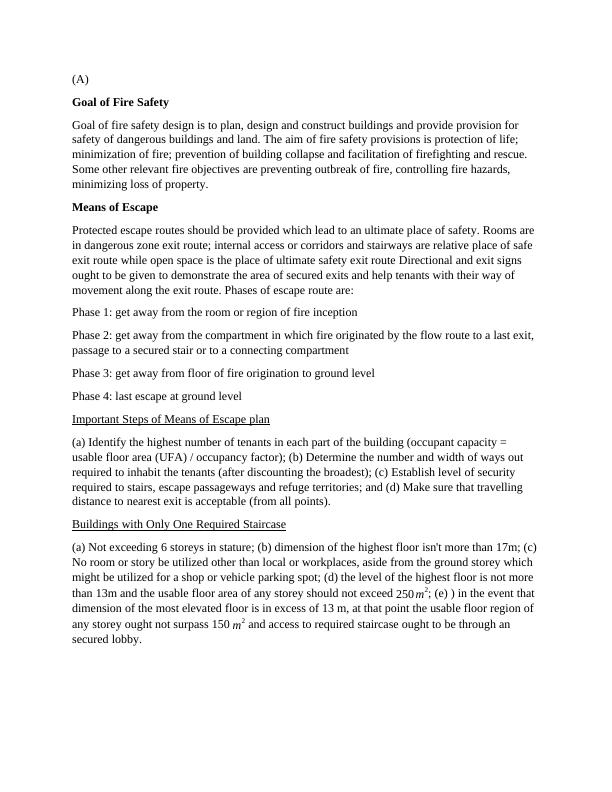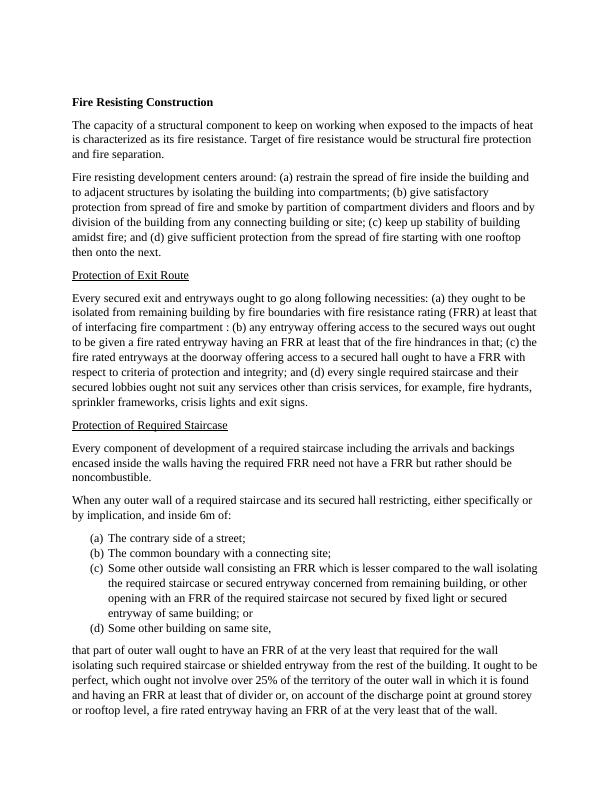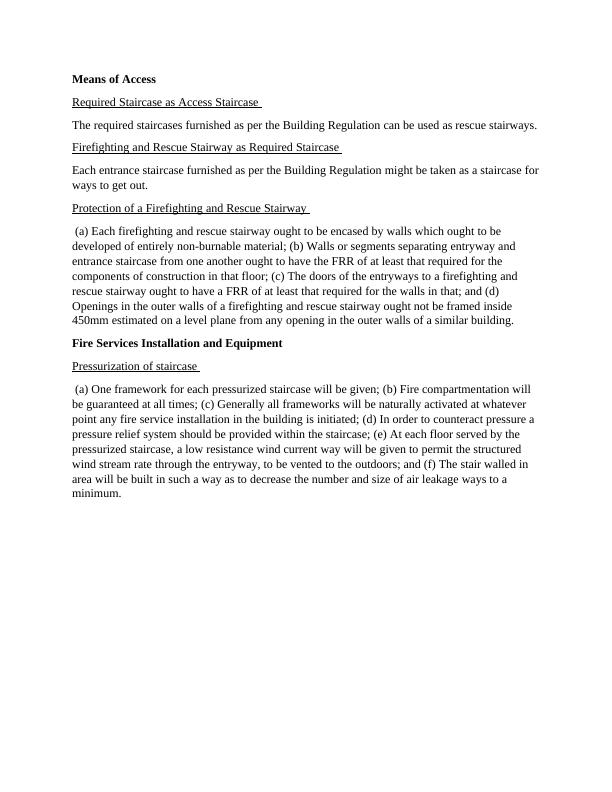Ask a question from expert
Fire Safety Design for Buildings and Protection
13 Pages3512 Words357 Views
Added on 2019-10-16
Fire Safety Design for Buildings and Protection
Added on 2019-10-16
BookmarkShareRelated Documents
(A)Goal of Fire SafetyGoal of fire safety design is to plan, design and construct buildings and provide provision for safety of dangerous buildings and land. The aim of fire safety provisions is protection of life; minimization of fire; prevention of building collapse and facilitation of firefighting and rescue. Some other relevant fire objectives are preventing outbreak of fire, controlling fire hazards, minimizing loss of property.Means of EscapeProtected escape routes should be provided which lead to an ultimate place of safety. Rooms are in dangerous zone exit route; internal access or corridors and stairways are relative place of safe exit route while open space is the place of ultimate safety exit route Directional and exit signs ought to be given to demonstrate the area of secured exits and help tenants with their way of movement along the exit route. Phases of escape route are: Phase 1: get away from the room or region of fire inception Phase 2: get away from the compartment in which fire originated by the flow route to a last exit, passage to a secured stair or to a connecting compartment Phase 3: get away from floor of fire origination to ground level Phase 4: last escape at ground level Important Steps of Means of Escape plan(a) Identify the highest number of tenants in each part of the building (occupant capacity = usable floor area (UFA) / occupancy factor); (b) Determine the number and width of ways out required to inhabit the tenants (after discounting the broadest); (c) Establish level of security required to stairs, escape passageways and refuge territories; and (d) Make sure that travelling distance to nearest exit is acceptable (from all points).Buildings with Only One Required Staircase(a) Not exceeding 6 storeys in stature; (b) dimension of the highest floor isn't more than 17m; (c)No room or story be utilized other than local or workplaces, aside from the ground storey which might be utilized for a shop or vehicle parking spot; (d) the level of the highest floor is not more than 13m and the usable floor area of any storey should not exceed 250m2; (e) ) in the event that dimension of the most elevated floor is in excess of 13 m, at that point the usable floor region of any storey ought not surpass 150 m2 and access to required staircase ought to be through an secured lobby.

Access to Required Staircase(s) inside a BuildingWith at least two required staircases, it ought to be arranged such that: (a) each required staircaseis headed from an alternate direction given that deadends are allowed; (b) the entryway of one required staircase ought not be closer than 6m from the entryway or a some other comparable point of the required staircase measured along the wall, and (c) level separation along centreline of escape route between required staircase and other required staircases ought not surpass 48m. A secured lobby ought to be given to every required staircase being involved with a secured exit.Discharge value of staircases ought to be more than total capacity of building.A ventilated staircase possess openings that give compelling cross ventilation. Such staircase ought to have: (a) more than 50% of its perimeter exposed to outer air; long face of staircase having more than 50% of opening and other faces consisting more than 25% of opening; (b) length of opening to be estimated on plan and open from the highest point of the balustrade; and (c) openings to be evenly distributed across elevations.Development of Required Staircases (a) Required staircases to be orchestrated in straight flights without winders; (b) Each flight havenot in excess of 16 risers nor under 2 risers. Risers at least 225mm in width and not more than 175mm in tallness; (c) Width and length of landings given at top and base of each flight ought to be more than the width of required staircase; (d) Every required staircase ought to have a reasonable headroom of at least 2000mm; (e) No required staircase ought to surpass 1800mm in width. In the event that more extensive staircase required, it must be partitioned by a central handrail into independent areas to such an extent that each segment ought to be at least 1050mm however not more than 1800mm in width; and (f) Any required staircase which serves floors underneath the main rooftop ought to be kept on offering access to the main rooftop with no block consistently.

Fire Resisting ConstructionThe capacity of a structural component to keep on working when exposed to the impacts of heat is characterized as its fire resistance. Target of fire resistance would be structural fire protection and fire separation.Fire resisting development centers around: (a) restrain the spread of fire inside the building and to adjacent structures by isolating the building into compartments; (b) give satisfactory protection from spread of fire and smoke by partition of compartment dividers and floors and by division of the building from any connecting building or site; (c) keep up stability of building amidst fire; and (d) give sufficient protection from the spread of fire starting with one rooftop then onto the next. Protection of Exit RouteEvery secured exit and entryways ought to go along following necessities: (a) they ought to be isolated from remaining building by fire boundaries with fire resistance rating (FRR) at least thatof interfacing fire compartment : (b) any entryway offering access to the secured ways out ought to be given a fire rated entryway having an FRR at least that of the fire hindrances in that; (c) thefire rated entryways at the doorway offering access to a secured hall ought to have a FRR with respect to criteria of protection and integrity; and (d) every single required staircase and their secured lobbies ought not suit any services other than crisis services, for example, fire hydrants, sprinkler frameworks, crisis lights and exit signs.Protection of Required StaircaseEvery component of development of a required staircase including the arrivals and backings encased inside the walls having the required FRR need not have a FRR but rather should be noncombustible. When any outer wall of a required staircase and its secured hall restricting, either specifically or by implication, and inside 6m of: (a)The contrary side of a street;(b)The common boundary with a connecting site;(c)Some other outside wall consisting an FRR which is lesser compared to the wall isolatingthe required staircase or secured entryway concerned from remaining building, or other opening with an FRR of the required staircase not secured by fixed light or secured entryway of same building; or(d)Some other building on same site,that part of outer wall ought to have an FRR of at the very least that required for the wall isolating such required staircase or shielded entryway from the rest of the building. It ought to beperfect, which ought not involve over 25% of the territory of the outer wall in which it is found and having an FRR at least that of divider or, on account of the discharge point at ground storey or rooftop level, a fire rated entryway having an FRR of at the very least that of the wall.

Means of AccessRequired Staircase as Access Staircase The required staircases furnished as per the Building Regulation can be used as rescue stairways.Firefighting and Rescue Stairway as Required Staircase Each entrance staircase furnished as per the Building Regulation might be taken as a staircase forways to get out. Protection of a Firefighting and Rescue Stairway (a) Each firefighting and rescue stairway ought to be encased by walls which ought to be developed of entirely non-burnable material; (b) Walls or segments separating entryway and entrance staircase from one another ought to have the FRR of at least that required for the components of construction in that floor; (c) The doors of the entryways to a firefighting and rescue stairway ought to have a FRR of at least that required for the walls in that; and (d) Openings in the outer walls of a firefighting and rescue stairway ought not be framed inside 450mm estimated on a level plane from any opening in the outer walls of a similar building. Fire Services Installation and EquipmentPressurization of staircase (a) One framework for each pressurized staircase will be given; (b) Fire compartmentation will be guaranteed at all times; (c) Generally all frameworks will be naturally activated at whatever point any fire service installation in the building is initiated; (d) In order to counteract pressure a pressure relief system should be provided within the staircase; (e) At each floor served by the pressurized staircase, a low resistance wind current way will be given to permit the structured wind stream rate through the entryway, to be vented to the outdoors; and (f) The stair walled in area will be built in such a way as to decrease the number and size of air leakage ways to a minimum.

End of preview
Want to access all the pages? Upload your documents or become a member.